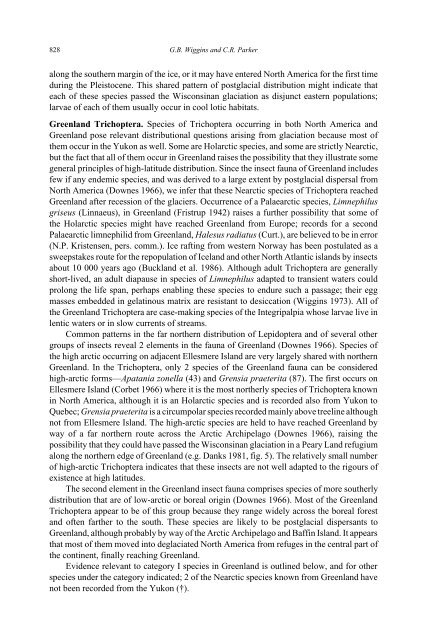Caddisflies of the Yukon - Department of Biological Sciences ...
Caddisflies of the Yukon - Department of Biological Sciences ...
Caddisflies of the Yukon - Department of Biological Sciences ...
Create successful ePaper yourself
Turn your PDF publications into a flip-book with our unique Google optimized e-Paper software.
828 G.B. Wiggins and C.R. Parker<br />
along <strong>the</strong> sou<strong>the</strong>rn margin <strong>of</strong> <strong>the</strong> ice, or it may have entered North America for <strong>the</strong> first time<br />
during <strong>the</strong> Pleistocene. This shared pattern <strong>of</strong> postglacial distribution might indicate that<br />
each <strong>of</strong> <strong>the</strong>se species passed <strong>the</strong> Wisconsinan glaciation as disjunct eastern populations;<br />
larvae <strong>of</strong> each <strong>of</strong> <strong>the</strong>m usually occur in cool lotic habitats.<br />
Greenland Trichoptera. Species <strong>of</strong> Trichoptera occurring in both North America and<br />
Greenland pose relevant distributional questions arising from glaciation because most <strong>of</strong><br />
<strong>the</strong>m occur in <strong>the</strong> <strong>Yukon</strong> as well. Some are Holarctic species, and some are strictly Nearctic,<br />
but <strong>the</strong> fact that all <strong>of</strong> <strong>the</strong>m occur in Greenland raises <strong>the</strong> possibility that <strong>the</strong>y illustrate some<br />
general principles <strong>of</strong> high-latitude distribution. Since <strong>the</strong> insect fauna <strong>of</strong> Greenland includes<br />
few if any endemic species, and was derived to a large extent by postglacial dispersal from<br />
North America (Downes 1966), we infer that <strong>the</strong>se Nearctic species <strong>of</strong> Trichoptera reached<br />
Greenland after recession <strong>of</strong> <strong>the</strong> glaciers. Occurrence <strong>of</strong> a Palaearctic species, Limnephilus<br />
griseus (Linnaeus), in Greenland (Fristrup 1942) raises a fur<strong>the</strong>r possibility that some <strong>of</strong><br />
<strong>the</strong> Holarctic species might have reached Greenland from Europe; records for a second<br />
Palaearctic limnephilid from Greenland, Halesus radiatus (Curt.), are believed to be in error<br />
(N.P. Kristensen, pers. comm.). Ice rafting from western Norway has been postulated as a<br />
sweepstakes route for <strong>the</strong> repopulation <strong>of</strong> Iceland and o<strong>the</strong>r North Atlantic islands by insects<br />
about 10 000 years ago (Buckland et al. 1986). Although adult Trichoptera are generally<br />
short-lived, an adult diapause in species <strong>of</strong> Limnephilus adapted to transient waters could<br />
prolong <strong>the</strong> life span, perhaps enabling <strong>the</strong>se species to endure such a passage; <strong>the</strong>ir egg<br />
masses embedded in gelatinous matrix are resistant to desiccation (Wiggins 1973). All <strong>of</strong><br />
<strong>the</strong> Greenland Trichoptera are case-making species <strong>of</strong> <strong>the</strong> Integripalpia whose larvae live in<br />
lentic waters or in slow currents <strong>of</strong> streams.<br />
Common patterns in <strong>the</strong> far nor<strong>the</strong>rn distribution <strong>of</strong> Lepidoptera and <strong>of</strong> several o<strong>the</strong>r<br />
groups <strong>of</strong> insects reveal 2 elements in <strong>the</strong> fauna <strong>of</strong> Greenland (Downes 1966). Species <strong>of</strong><br />
<strong>the</strong> high arctic occurring on adjacent Ellesmere Island are very largely shared with nor<strong>the</strong>rn<br />
Greenland. In <strong>the</strong> Trichoptera, only 2 species <strong>of</strong> <strong>the</strong> Greenland fauna can be considered<br />
high-arctic forms—Apatania zonella (43) and Grensia praeterita (87). The first occurs on<br />
Ellesmere Island (Corbet 1966) where it is <strong>the</strong> most nor<strong>the</strong>rly species <strong>of</strong> Trichoptera known<br />
in North America, although it is an Holarctic species and is recorded also from <strong>Yukon</strong> to<br />
Quebec; Grensia praeterita is a circumpolar species recorded mainly above treeline although<br />
not from Ellesmere Island. The high-arctic species are held to have reached Greenland by<br />
way <strong>of</strong> a far nor<strong>the</strong>rn route across <strong>the</strong> Arctic Archipelago (Downes 1966), raising <strong>the</strong><br />
possibility that <strong>the</strong>y could have passed <strong>the</strong> Wisconsinan glaciation in a Peary Land refugium<br />
along <strong>the</strong> nor<strong>the</strong>rn edge <strong>of</strong> Greenland (e.g. Danks 1981, fig. 5). The relatively small number<br />
<strong>of</strong> high-arctic Trichoptera indicates that <strong>the</strong>se insects are not well adapted to <strong>the</strong> rigours <strong>of</strong><br />
existence at high latitudes.<br />
The second element in <strong>the</strong> Greenland insect fauna comprises species <strong>of</strong> more sou<strong>the</strong>rly<br />
distribution that are <strong>of</strong> low-arctic or boreal origin (Downes 1966). Most <strong>of</strong> <strong>the</strong> Greenland<br />
Trichoptera appear to be <strong>of</strong> this group because <strong>the</strong>y range widely across <strong>the</strong> boreal forest<br />
and <strong>of</strong>ten far<strong>the</strong>r to <strong>the</strong> south. These species are likely to be postglacial dispersants to<br />
Greenland, although probably by way <strong>of</strong> <strong>the</strong> Arctic Archipelago and Baffin Island. It appears<br />
that most <strong>of</strong> <strong>the</strong>m moved into deglaciated North America from refuges in <strong>the</strong> central part <strong>of</strong><br />
<strong>the</strong> continent, finally reaching Greenland.<br />
Evidence relevant to category I species in Greenland is outlined below, and for o<strong>the</strong>r<br />
species under <strong>the</strong> category indicated; 2 <strong>of</strong> <strong>the</strong> Nearctic species known from Greenland have<br />
not been recorded from <strong>the</strong> <strong>Yukon</strong> (†).
















